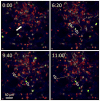Intravital imaging of anti-tumor immune response and the tumor microenvironment
- PMID: 20652252
- PMCID: PMC2971683
- DOI: 10.1007/s00281-010-0217-9
Intravital imaging of anti-tumor immune response and the tumor microenvironment
Abstract
Tumor growth, invasiveness, and metastasis are dynamic processes involving cancer interactions with the extracellular matrix, the vasculature, and various types of non-cancerous host cells that form the tumor stroma. An often-present stromal component is the immune cells, such as tumor-associated myeloid and lymphocytic infiltrates, yet endogenous anti-tumor immune responses are typically ineffective in tumor rejection and may even contribute to the progression of some cancers. How exactly cancer cells interact with the stroma and invade healthy tissues while avoiding anti-tumor immune responses, and which interactions should be targeted for anti-tumor therapy, can now be studied by minimally invasive observation using multiphoton and other low impact confocal microscopy techniques and fluorescent animal tumor models. Intravital video microscopy has already been instrumental in defining the roles and modes of cellular motility in the angiogenic process and during tissue invasion at the tumor margin. In the hands of cancer immunologists, intravital video microscopy is beginning to unravel the complexity of effector and suppressory lymphocytic interactions in tumors and in the draining lymphoid organs. As the intravital microscopy approach is beginning to move beyond fundamental description and into analyzing the molecular underpinnings of cell's dynamics, future technical advances will undoubtedly provide yet deeper insight while stitching together a systems dynamics view of cancer-host interactions that will keep on inspiring cancer researchers and therapists.
Figures


Similar articles
-
Two-photon imaging of effector T-cell behavior: lessons from a tumor model.Immunol Rev. 2008 Feb;221:147-62. doi: 10.1111/j.1600-065X.2008.00596.x. Immunol Rev. 2008. PMID: 18275480 Review.
-
Frontiers in Intravital Multiphoton Microscopy of Cancer.Cancer Rep (Hoboken). 2020 Feb;3(1):e1192. doi: 10.1002/cnr2.1192. Epub 2019 Jun 20. Cancer Rep (Hoboken). 2020. PMID: 32368722 Free PMC article. Review.
-
Time-lapsed, large-volume, high-resolution intravital imaging for tissue-wide analysis of single cell dynamics.Methods. 2017 Sep 1;128:65-77. doi: 10.1016/j.ymeth.2017.07.019. Methods. 2017. PMID: 28911733 Free PMC article.
-
Migration of Regulatory T Cells to the Peritumor Microenvironment of Experimental Glioblastoma.Sovrem Tekhnologii Med. 2025;17(1):70-78. doi: 10.17691/stm2025.17.1.07. Epub 2025 Feb 28. Sovrem Tekhnologii Med. 2025. PMID: 40071070 Free PMC article.
-
Merger of dynamic two-photon and phosphorescence lifetime microscopy reveals dependence of lymphocyte motility on oxygen in solid and hematological tumors.J Immunother Cancer. 2019 Mar 18;7(1):78. doi: 10.1186/s40425-019-0543-y. J Immunother Cancer. 2019. PMID: 30885258 Free PMC article.
Cited by
-
Characterization of the Tumor Microenvironment and Tumor-Stroma Interaction by Non-invasive Preclinical Imaging.Front Oncol. 2017 Jan 31;7:3. doi: 10.3389/fonc.2017.00003. eCollection 2017. Front Oncol. 2017. PMID: 28197395 Free PMC article. Review.
-
Improved Progression-Free Survival Associated with Tumor-Infiltrating Lymphocytes in High-Grade Endometrial Cancer.J Clin Med. 2023 Jan 11;12(2):603. doi: 10.3390/jcm12020603. J Clin Med. 2023. PMID: 36675532 Free PMC article.
-
Longitudinal imaging of T cell-based immunotherapy with multi-spectral, multi-scale optoacoustic tomography.Sci Rep. 2020 Mar 17;10(1):4903. doi: 10.1038/s41598-020-61191-z. Sci Rep. 2020. PMID: 32184401 Free PMC article.
-
Two-photon and second harmonic microscopy in clinical and translational cancer research.Ann Biomed Eng. 2012 Feb;40(2):277-91. doi: 10.1007/s10439-012-0512-9. Epub 2012 Jan 19. Ann Biomed Eng. 2012. PMID: 22258888 Free PMC article. Review.
-
Prognostic impact of immune microenvironment in laryngeal and pharyngeal squamous cell carcinoma: Immune cell subtypes, immuno-suppressive pathways and clinicopathologic characteristics.Oncotarget. 2017 Mar 21;8(12):19310-19322. doi: 10.18632/oncotarget.14242. Oncotarget. 2017. PMID: 28038471 Free PMC article.
References
-
- Peggs KS, Quezada SA, Korman AJ, Allison JP. Principles and use of anti-CTLA4 antibody in human cancer immunotherapy. Curr Opin Immunol. 2006;18:206–213. - PubMed
-
- Sakaguchi S, Sakaguchi N, Asano M, Itoh M, Toda M. Immunologic self-tolerance maintained by activated T cells expressing IL-2 receptor alpha-chains (CD25). Breakdown of a single mechanism of self-tolerance causes various autoimmune diseases. J Immunol. 1995;155:1151–1164. - PubMed
-
- Shimizu J, Yamazaki S, Sakaguchi S. Induction of tumor immunity by removing CD25+CD4+ T cells: a common basis between tumor immunity and autoimmunity. J Immunol. 1999;163:5211–5218. - PubMed
-
- Fontenot JD, Gavin MA, Rudensky AY. Foxp3 programs the development and function of CD4+CD25+ regulatory T cells. Nat Immunol. 2003;4:330–336. - PubMed
Publication types
MeSH terms
Substances
Grants and funding
LinkOut - more resources
Full Text Sources
Other Literature Sources
Research Materials

